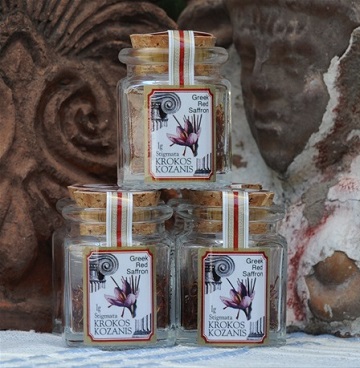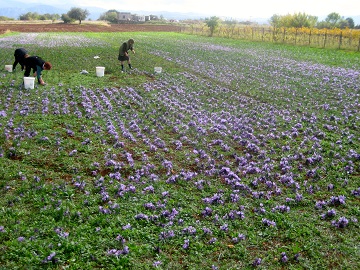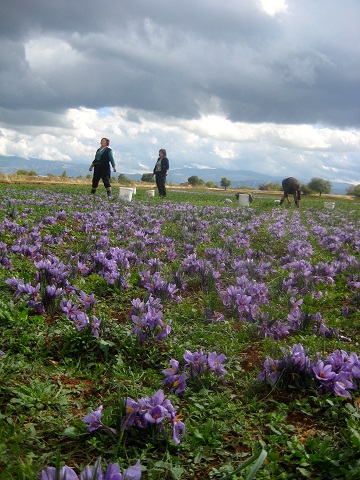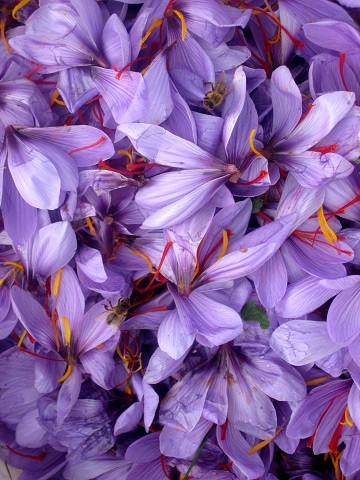Saffron is the most precious of spices. Saffron is derived from the dried red stigmas of the purple flowers of the Crocus sativus or Saffron Crocus. On average, over 150 flowers or 450 stigmas (each flower contains only 3) are required to produce 1 gram of saffron---the equivalent of roughly 75,000 flowers to produce 1 pound of the spice.
 Wild crocus has a long history in the Mediterranean world. At some point, deliberate human cultivation of the flower began with preference given to plants producing flower with unusually long stigmas. The domesticated ancestor of the modern Crocus sativus emerged in late Bronze Age Crete. Nearly 4,000 year old frescoes depicting saffron gatherers are to be found on the palace walls of the ancient Minoans of Greece. The ancients recognized saffron for both its therapeutic and sensual properties. Saffron was considered food, medicine and perfume and was the province of chefs, courtesans and healers alike.
Wild crocus has a long history in the Mediterranean world. At some point, deliberate human cultivation of the flower began with preference given to plants producing flower with unusually long stigmas. The domesticated ancestor of the modern Crocus sativus emerged in late Bronze Age Crete. Nearly 4,000 year old frescoes depicting saffron gatherers are to be found on the palace walls of the ancient Minoans of Greece. The ancients recognized saffron for both its therapeutic and sensual properties. Saffron was considered food, medicine and perfume and was the province of chefs, courtesans and healers alike.
Saffron production continues today around the villages of Kozani in northern Greece using the same labor intensive and organic techniques that would be familiar to the ancient Minoans. Once a year in autumn, the crocus harvest begins as the flowers start to bloom. The crocus is a delicate flower which withers rapidly after being picked.
Each day is a race against time, as flowers are laboriously picked by hand starting at sunrise and gathered into baskets. The evenings are devoted to carefully hand sorting the petals from the stamens and the stigmas of the flowers in preparation for drying. The harvest continues for about three weeks until the annual bloom is over.
The stigmas and stamens are laid out on wire and silk mesh frames in well ventilated warm rooms to dry over the course of the winter. Proper drying is a delicate procedure requiring great skill and care as it is critical to the saffron retaining its distinctive properties unaltered and undiminished. When drying is complete, a final hand sorting is done where stamens and pollen are carefully removed leaving behind the pure saffron.
The final processing and packaging of Greece's saffron is overseen by the Cooperative of Saffron Producers of Kozani which was formed in 1971 to protect the interests of the farmers and to assure the integrity and purity of the product. The region was granted status as a protected designation of origin in 1982.
From a scientific standpoint, saffron is graded by laboratory measurements of characteristics relating to color, taste and fragrance. According to these standards, Greek saffron measures as the best in the world. The final proof of quality, however, is to be found not in the laboratory, but in the kitchen and on the plate where the lovely complexity of flavor and strength of coloring of Greek saffron are revealed.
Tagaras is very proud to introduce this beautiful artisanal product from the north of Greece to Los Angeles.






